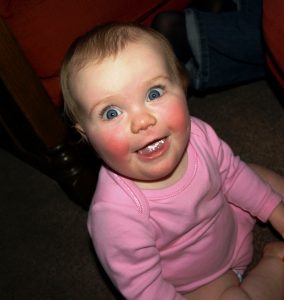Neurodevelopment = the process of development of pathways in the brain that influence performance or functioning.
Thanks to neuro-plasticity, neurodevelopment applies throughout our lives. But never more than up to the age of 1 year.
- Everything you do or experience builds pathways to improve your neurodevelopment.
- Movement is key for a baby, so appropriate opportunities are vital.
- The more regular the repetition, the more the pathways are strengthened.
- Limitations in neurodevelopment can affect any aspect of a child’s functioning.
- Early brain development influences future capability, happiness and relationships.
Human Development
The most ra pid phase of neurodevelopment occurs in the primal period from conception to a child’s first birthday.
pid phase of neurodevelopment occurs in the primal period from conception to a child’s first birthday.
A critical period is in the first 6 months after being born.
In utero

The brain starts by developing the functions of the brain stem, often called the reptilian brain. This is the most primitive part of a brain. It responds to stimuli with a movement or a function. It is always the same. There is no control or intention. These are known as infant reflexes.
At birth

At birth the baby moves and functions under the control of this group of reflexes. There are reflexes to curl the body in the correct position in utero, to help the baby wriggle to be born, to turn the baby in the last stage of delivery and to help the baby’s hands cling and make the bladder work. Most important of all The Moro reflex activates the first breath of life.
Of course, in the case of a C-section birth, some of these infant reflexes are not used. So, they are more likely to persist.
Sometimes one or more of the reflexes fail to develop. This can show, for example, as a baby in breech position, or lying transversely, ie. not curled up.
Birth is the time of greatest danger to a baby, especially through lack of oxygen which can result in injury to the brain, cerebral palsy. But it may also affect any aspect of brain function.
The first year of life

Gradually, during the first year of life these reflexes should become integrated. That is, they become less influential. The higher level of the brain begins to develop and take over with conscious movement and control.
Lack of opportunity to move freely in a horizontal position, stressful parenting, or neglect will all affect the cortisol levels in a baby which negatively affects the growth of the brain.
Research
Recent research covers a wide range of topics when studying the influences affecting the brain of a baby.
An international review, shows children have 33 per cent higher odds of developing autism spectrum disorder and 17 per cent higher odds of developing ADHD if they are born by C-section. 1
Rising incidence of neurodevelopmental-related issues.
A 2012 study revealed that 1 in 16 of children in the UK have a diagnosed disability, over half of these being neurodevelopmental (Jones, L, 2012). Diagnoses of Autism, ADHD, ADD, dyslexia and other developmental disorders have been reported to show steady increases above this level, since 2012.
Many teachers will be well aware of the rising numbers of children who experience neurodevelopmental-related issues, often without formal diagnosis.
It is even more worrying that this trend is worldwide. For example, in the United States, 1 in 6 children were reported to have a developmental disability in 2018. The overall trend increased by 6–15% each year from 2002 to 2010. (pediatrics.aap publications, 2011) and continues to rise.
ASD incidence in children – Recent research
These study samples vary with the range of ages, sample size and methodology. The rising trend is universal.
This is only one of the many developmental diagnoses.
Country
Japan: May 2021 1 in 35
Denmark: 2018 1 in 36
UK: March 2021 1 in 57
USA: 2020 1 in 59
Australia: 2018 1 in 70 (people)
America: 2008 1 in 88
India & Sri Lanka: 1 in 93
China: 2019 1 in 250 (1.4 billion children)
As the numbers increase, there is a growing need for intervention and the EBO for Schools program has been designed to help to meet this need.
The program can begin at any time, although the start of the school year is most popular. It’s your choice, so you have the flexibility at your fingertips that is needed in these uncertain times.
Adverse Childhood Experiences (A.C.E.).
Most teachers will know about A.C.E. and its impacts, but may be uncertain what to do about it. Adverse childhood experiences are now acknowledged as brain changing and the specific physical activities inherent in the BrainChild Developmental Program and EBO for Schools program are designed to help alleviate such changes.
The program works to help the brain recover from the impact of early adverse experiences. It is particularly relevant for looked-after and adopted children, but a surprisingly large number of children can be affected by other experiences dating as far back as pregnancy, the birth process or early management, which may have remained unacknowledged.
These children need specific help. Teachers can spot them. EBO is designed to help them.
References:
- Link to research (DOI): 10.1001/jamanetworkopen.2019.10236
The goal of neurodevelopment is to achieve the highest level of functioning that is possible for that individual.

You must be logged in to post a comment.